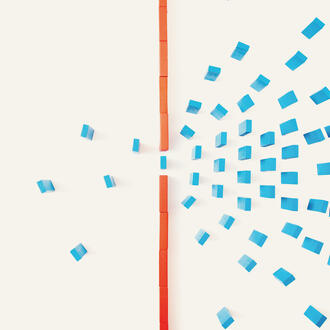Ideas Made to Matter
Operations Management
Predicting performance under pressure
By
Many industries subject current and prospective employees to stress tests to see how they might perform under pressure. Those who remain cool, calm, and collected during the simulations are often seen as the best fit for stressful real-life situations, whether it’s landing an airplane or trading on the stock exchange floor.
However, a recent paper by Juan Pablo Vielma, assistant professor of operations research, and Tauhid Zaman, assistant professor of operations management, at the MIT Sloan School of Management, along with graduate student Carter Mundell, may cause companies to think twice about how they view the results of such simulations.
By measuring galvanic skin response, known as GSR, over the course of an increasingly difficult exam, the trio found that those who perform best under duress are actually a little bit stressed when the stakes are lower. This, the authors said, can give firms a more accurate model for predicting employee performance.
Initial stress, improved performance
GSR, which is a measure of changes in skin resistance due to sweat, offers an easy way to measure stress, as the body’s sweat glands are connected to the central nervous system. As Zaman pointed out, polygraph tests measure GSR.
While the scientific literature has linked mental stress to performance for more than 100 years, most of the study of stress has focused on understanding it as opposed to predicting it, Zaman said.
“Everyone else was looking at, ‘Why are you stressed now?’” Vielma said. “We stumbled on whether they would be stressed in 10 minutes.”
In the study, graduate students were asked to do multiplication problems and received 25 cents for a correct answer. In the calibration round, there was no time limit. In the first round, participants received $1 for a correct answer during “bonus” time, which was 85 percent of the overall time limit. In the second round, the bonus time was shortened to 50 percent.
The participants who earned the most money in the high-stakes second round were more likely to have higher GSR levels during the calibration round. Those who earned the least, on the other hand, had much lower GSR levels in the calibration round.
While the study is scientific and not psychological, it suggests that initial levels of stress are a signal that someone is preparing for the task at hand. “They got in the zone pretty quickly,” Vielma said. “Maybe being nervous is a good thing.”
Fitness trackers and a maturing market for measuring GSR
When Mundell, Vielma, and Zaman began their research, there was much buzz in the wearable tech industry about the Apple Watch. They saw potential for the wrist-based biosensors in smartwatches or fitness bands to provide performance feedback to improve service operations.
But the market was still immature, so the trio conducted their exams using a finger sensor on participants’ non-dominant hand. This was effective but also limiting to further research, as participants would only have one free hand.
GSR has often been an overlooked feature in wearables, but now consumer-grade devices such as the Microsoft Band 2 and the Basis Peak watch include sensors that measure GSR.
With the increasing availability of these devices, said Zaman, who wears the Microsoft Band 2, the “paradigm totally shifts” for companies who want to make more informed decisions about who to hire, bring to a difficult negotiation, or put in charge of the most difficult tasks. No longer must firms rely on low-stress simulations—and learn after the fact that they may have hired the wrong people.
“The way you screen employees can change,” he said. “There’s one more piece of data to make a decision off of.”



